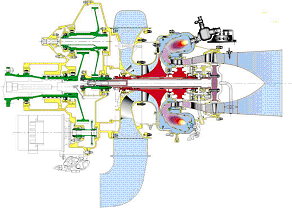Cesar
The project is supported by the European Commission with the contract number AIP5-CT-2006-03088.
Project full title: Cost-Effective Small Aircraft
Project acronym: CESAR
Summary
The CESAR project focuses on an enhanced development cycle and new technologies for a small-size commercial aircraft. CESAR will raise the competitiveness of its partners in the world market. The objective is to build up a new development concept for this aircraft category and to improve selected technologies enabling a significant reduction of the time-to-market factor and lowering the overall development, operation and maintenance costs, while considering safety, passenger comfort and environmental impact.
The project consists of five RTD areas sufficiently covering the complexity of the aircraft design process: aerodynamic and structural design, propulsion integration, aircraft system optimization and design integration aspects. The Institute of Energy Systems is involved in propulsion integration work package, namely dynamics of high speed turbomachinery.
Dynamics of high speed turbomachinery
Small commercial aircraft of this category requires a turboprop engine with power from 200 to 400 kW. The new design of the engine will be based on AI-450 engine (400 kW) produced by IVCHENKO Progress (Ukraine) and TJ100 (200 kW) engine produced by PBS (Czech Republic). The following objectives are pursued for a new turboprop propulsion unit:
- engine weight reduction by 7-9 %
- reduction of fuel specific consumption by 2-3 %
- service life parameters increasing by 10-15 %
- maintenance costs decreasing by 6-9 %
- reduction of noise emissions in the far field by 3 to 6 dB(A)
The concept of engine design to meet these requirements will result in application of several advanced technologies such as high speed engine core (= 55 000 rpm), high pressure ratio centrifugal compressor (9+), cooled turbine, high speed ratio propeller gear box, etc. These issues demand special attention to rotordynamics of the propulsion unit.
Objectives:
- Developing of theoretical tools for optimizing rotor dynamics of high speed rotating systems.
- Recommendations for high-speed bearing design.
- Optimization studies of gear box shafts rotor dynamics, gear box bearing configurations, etc.
Analysis tools: Modern finite element packages, in-house codes.
